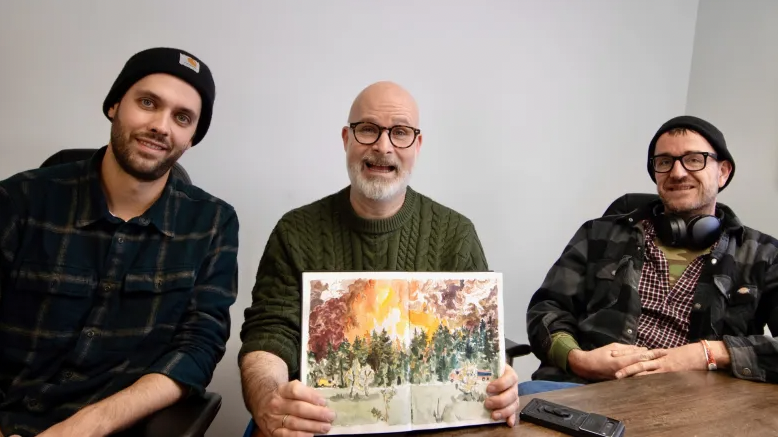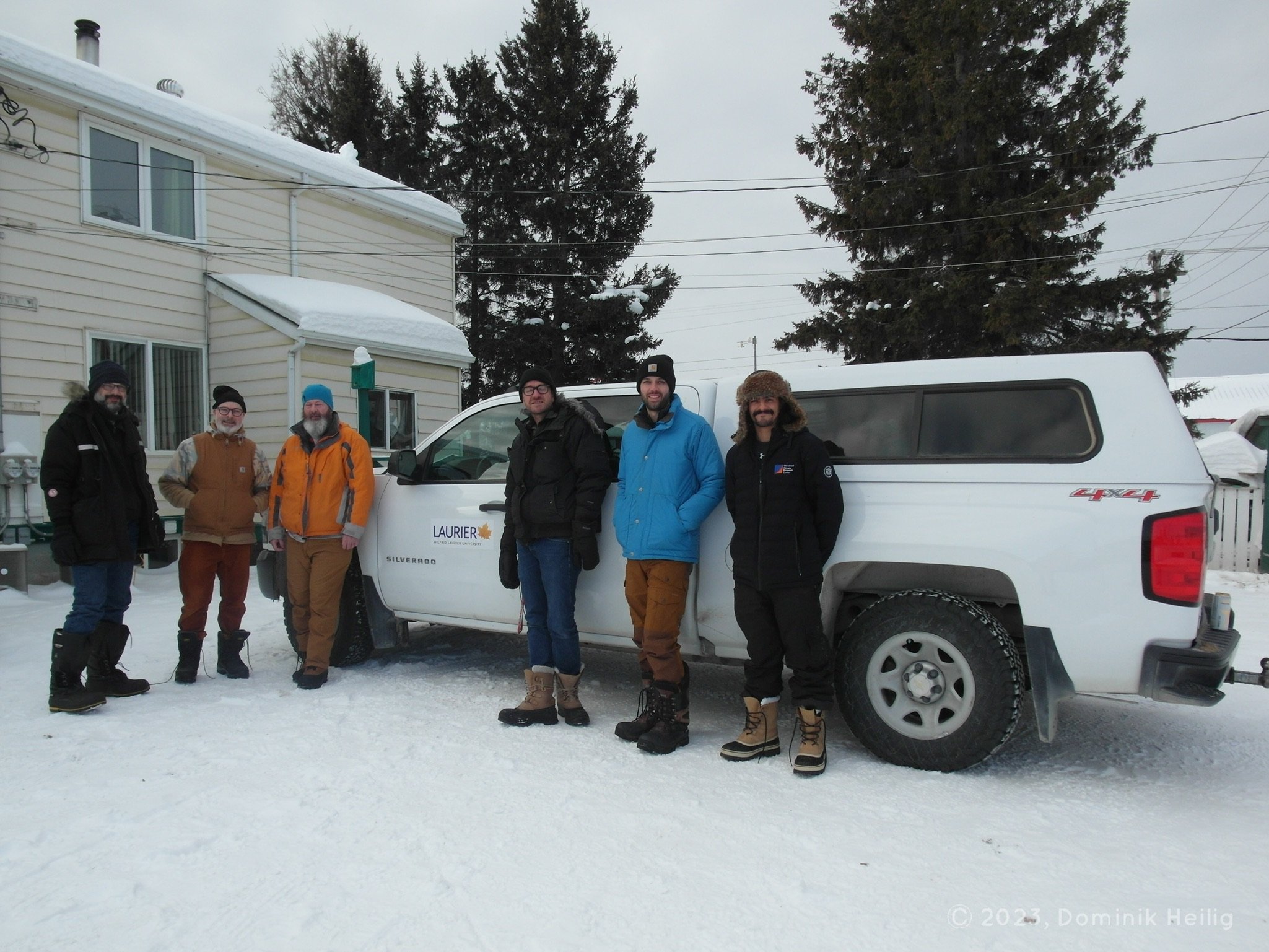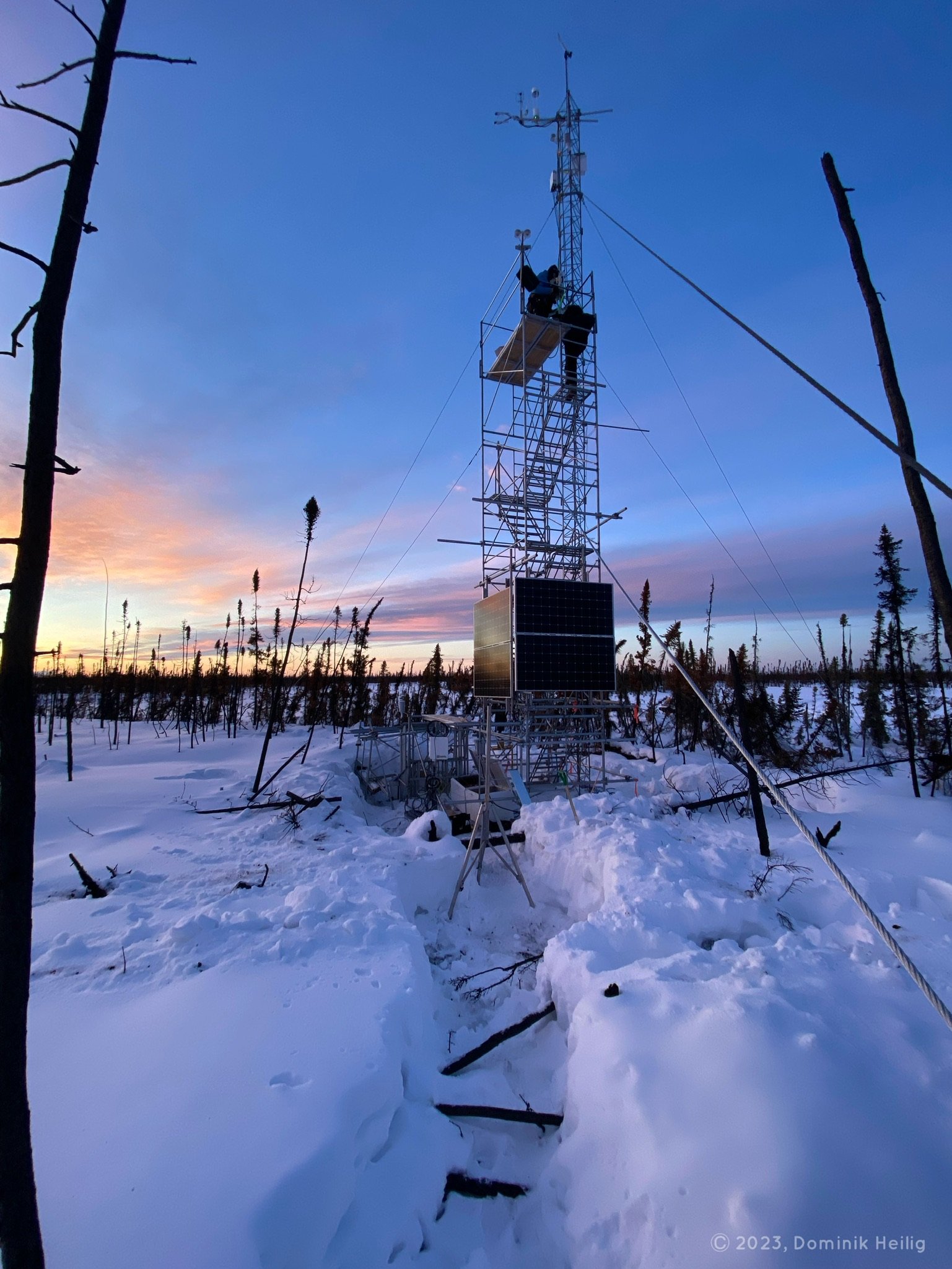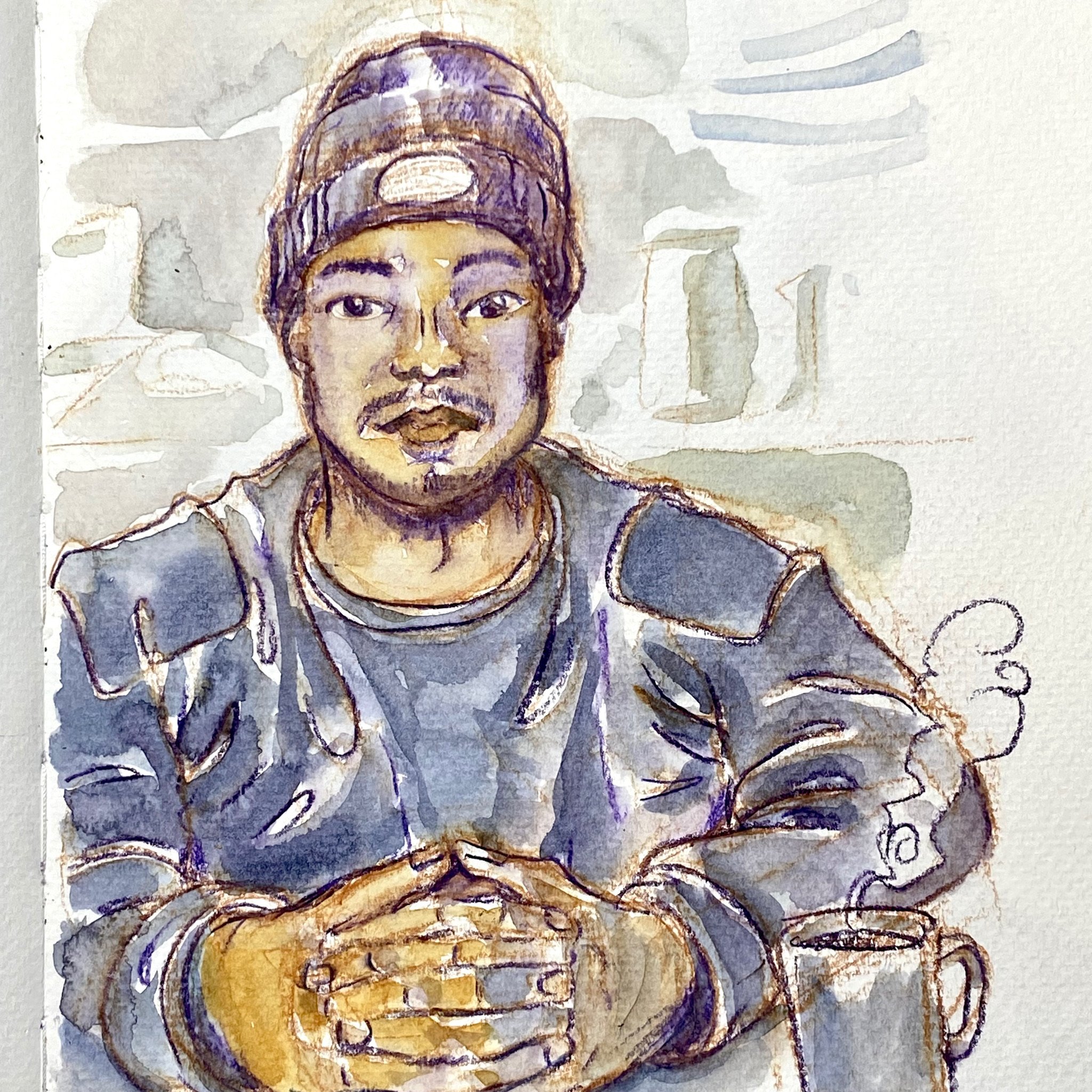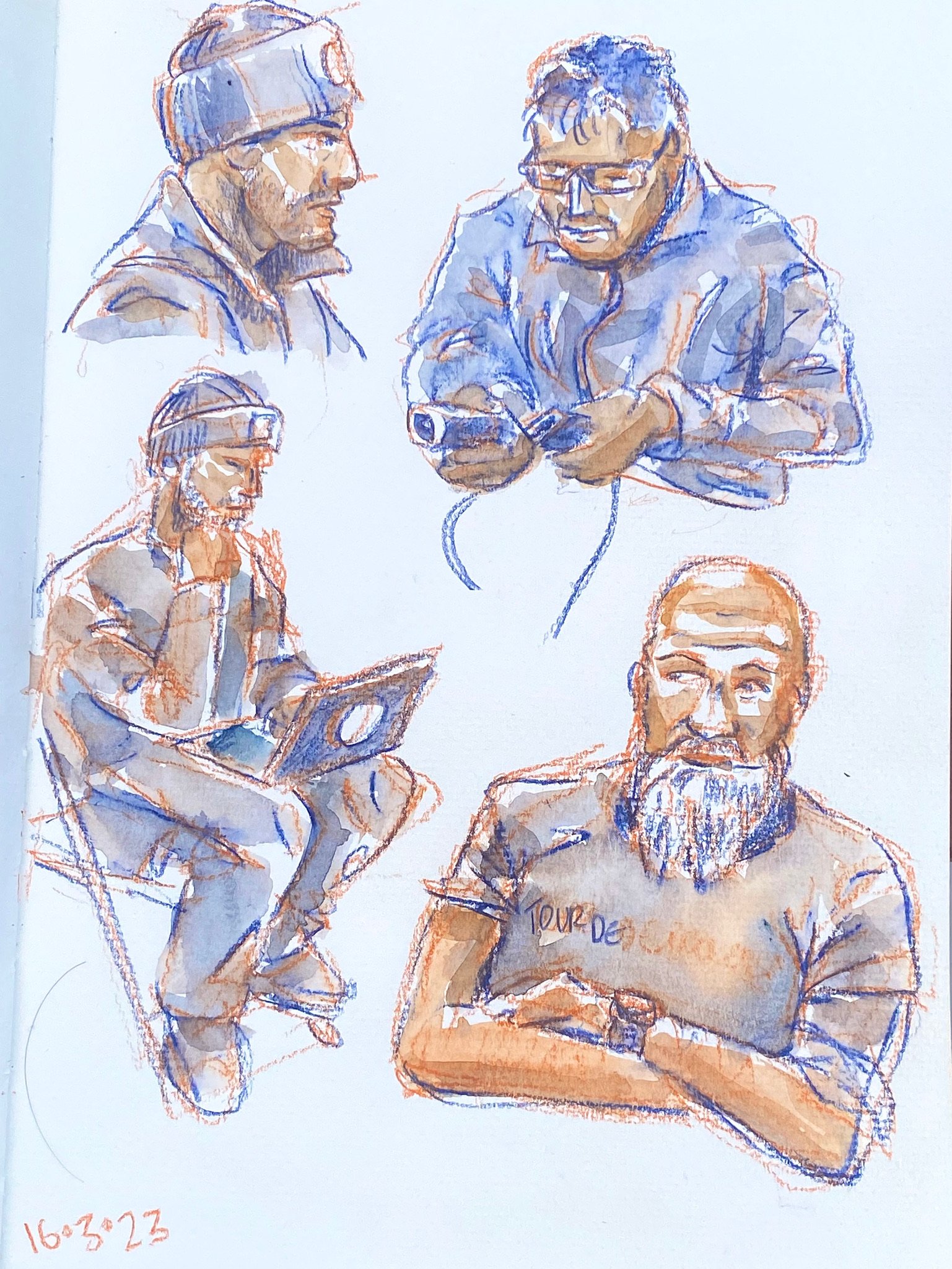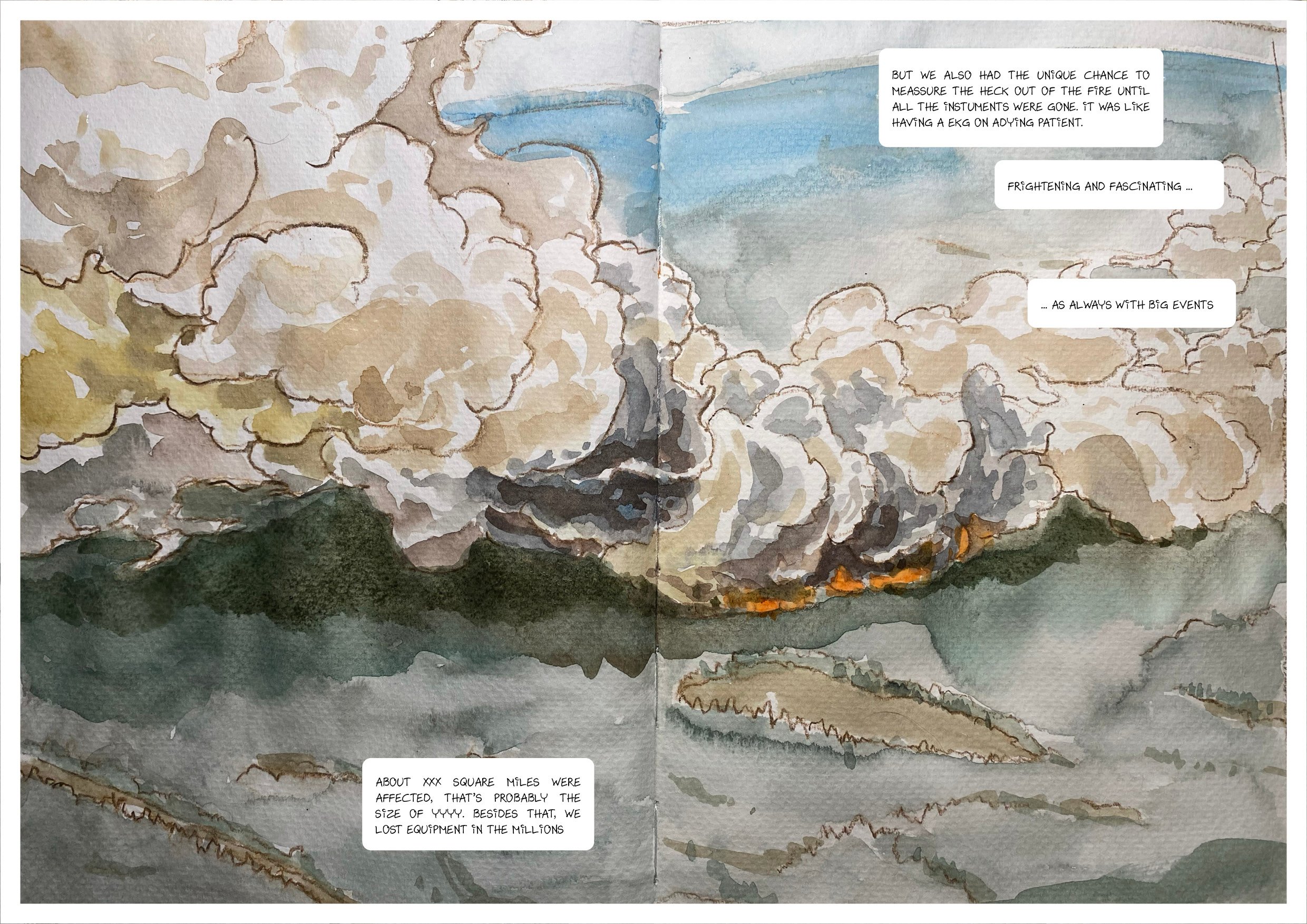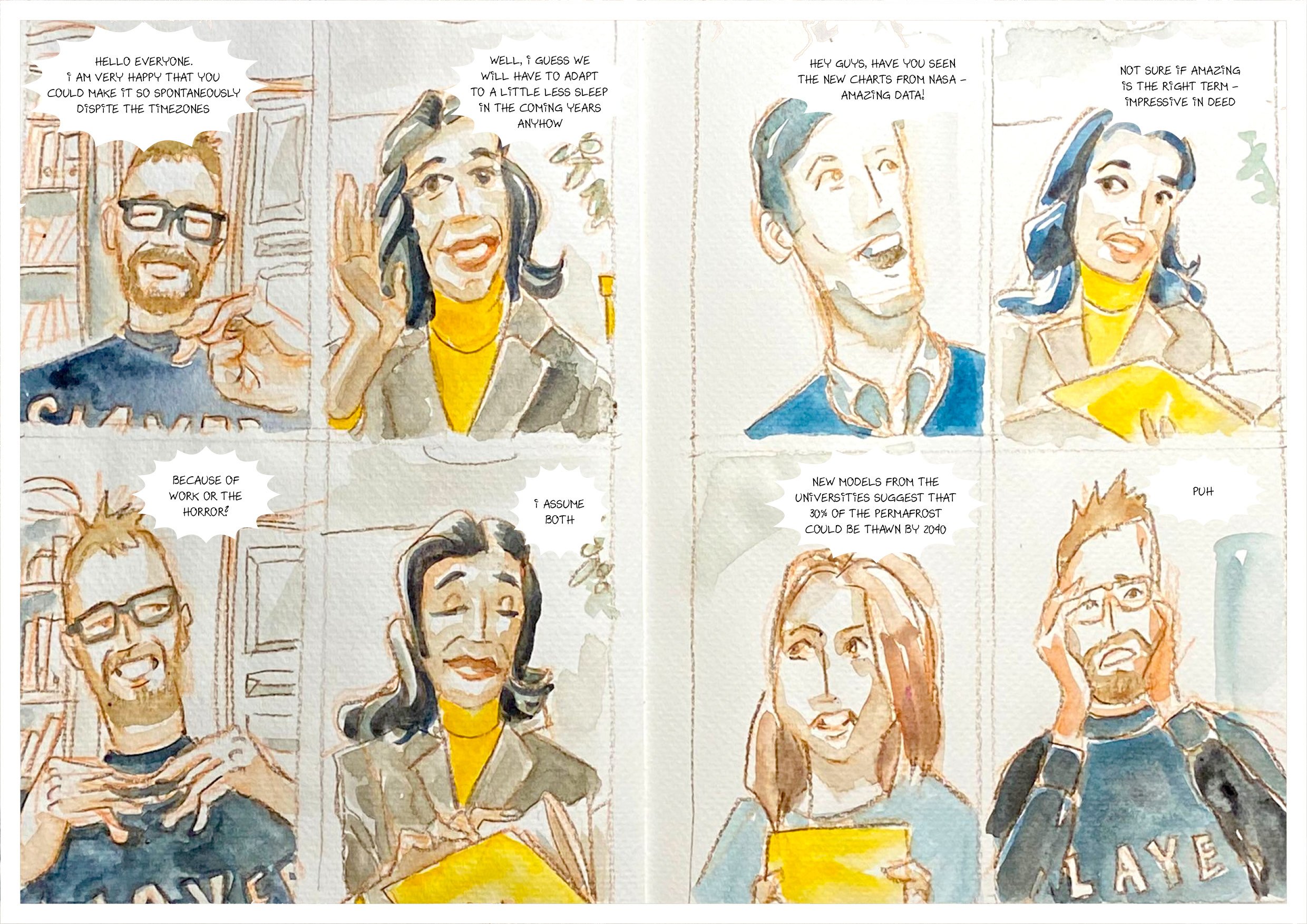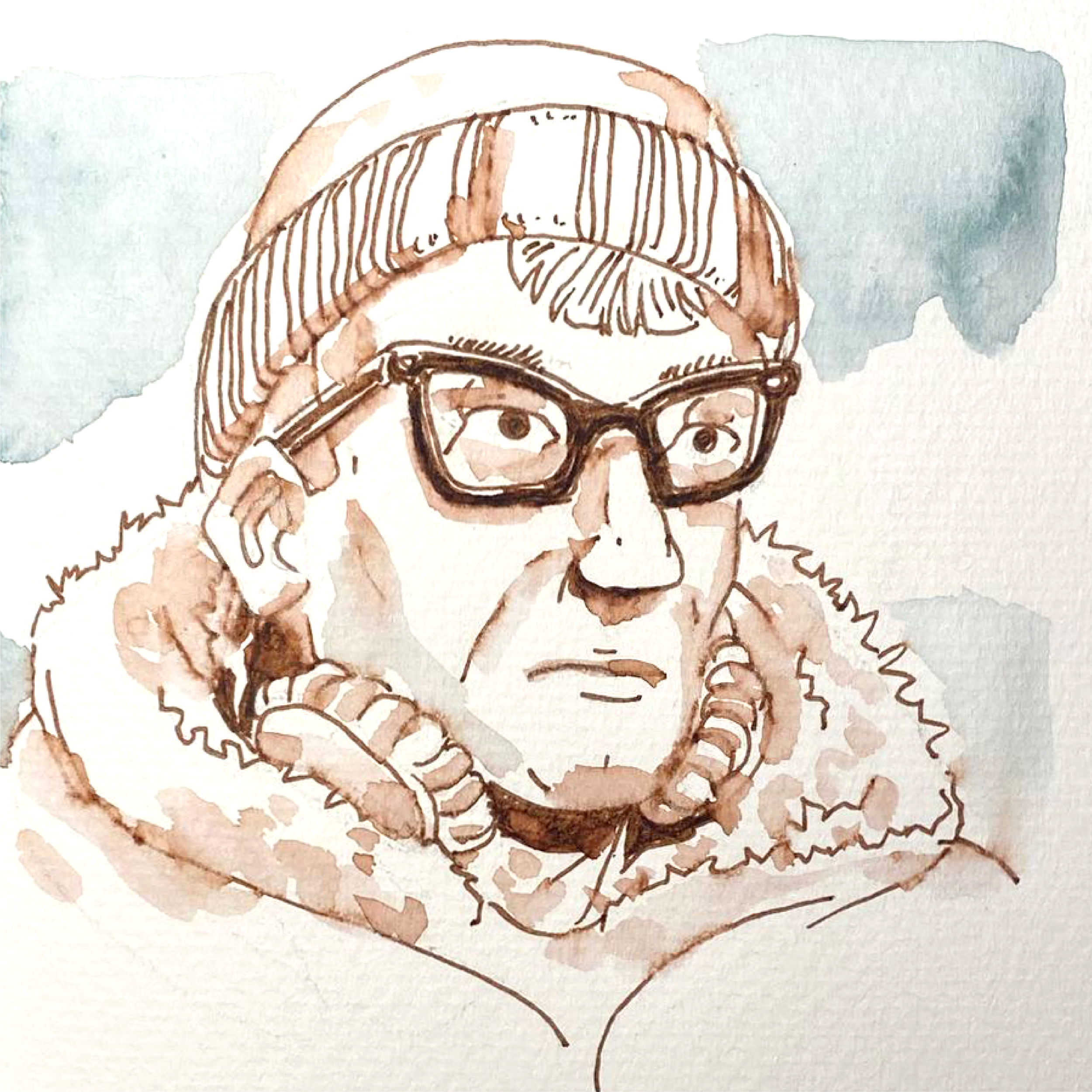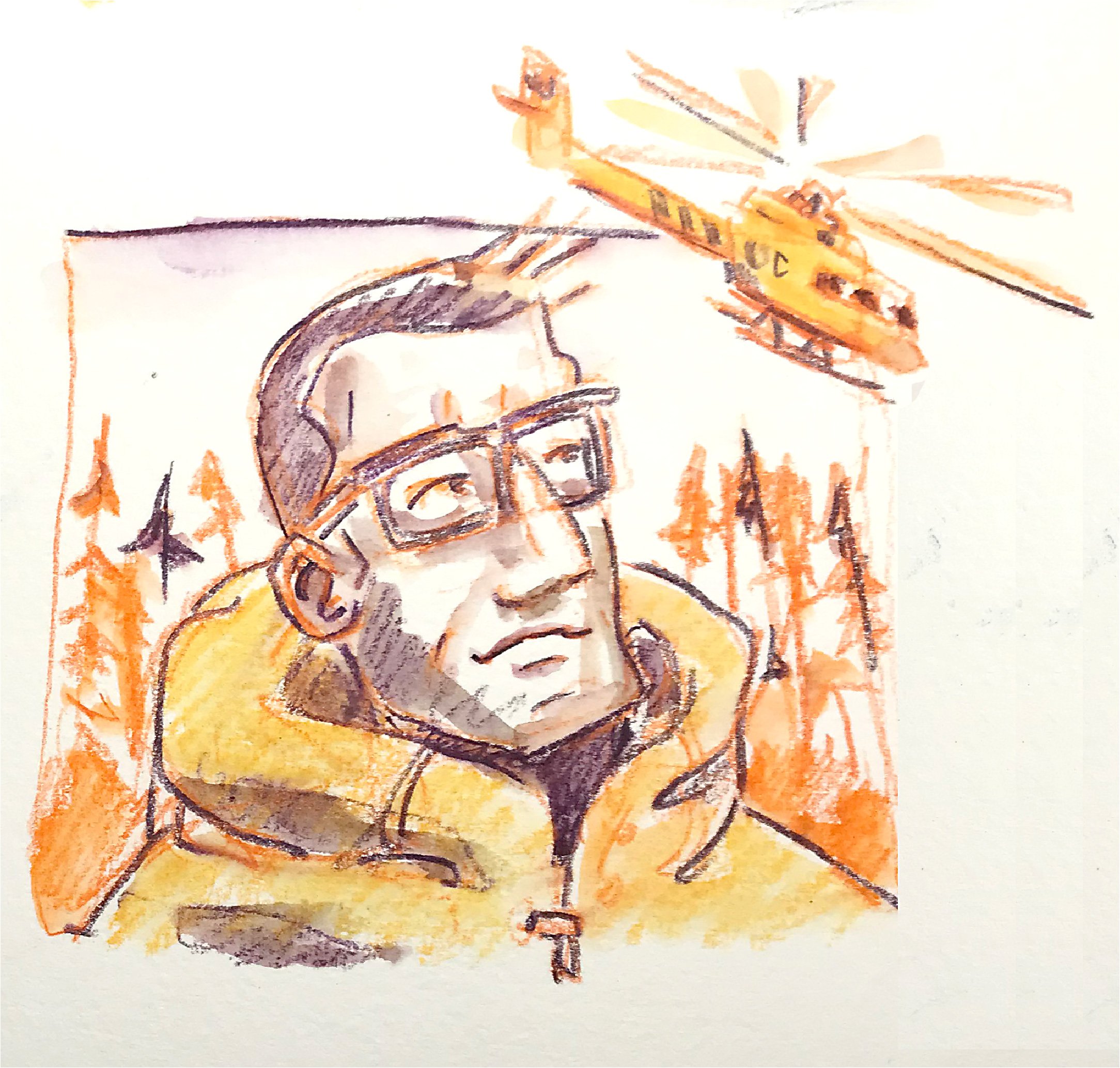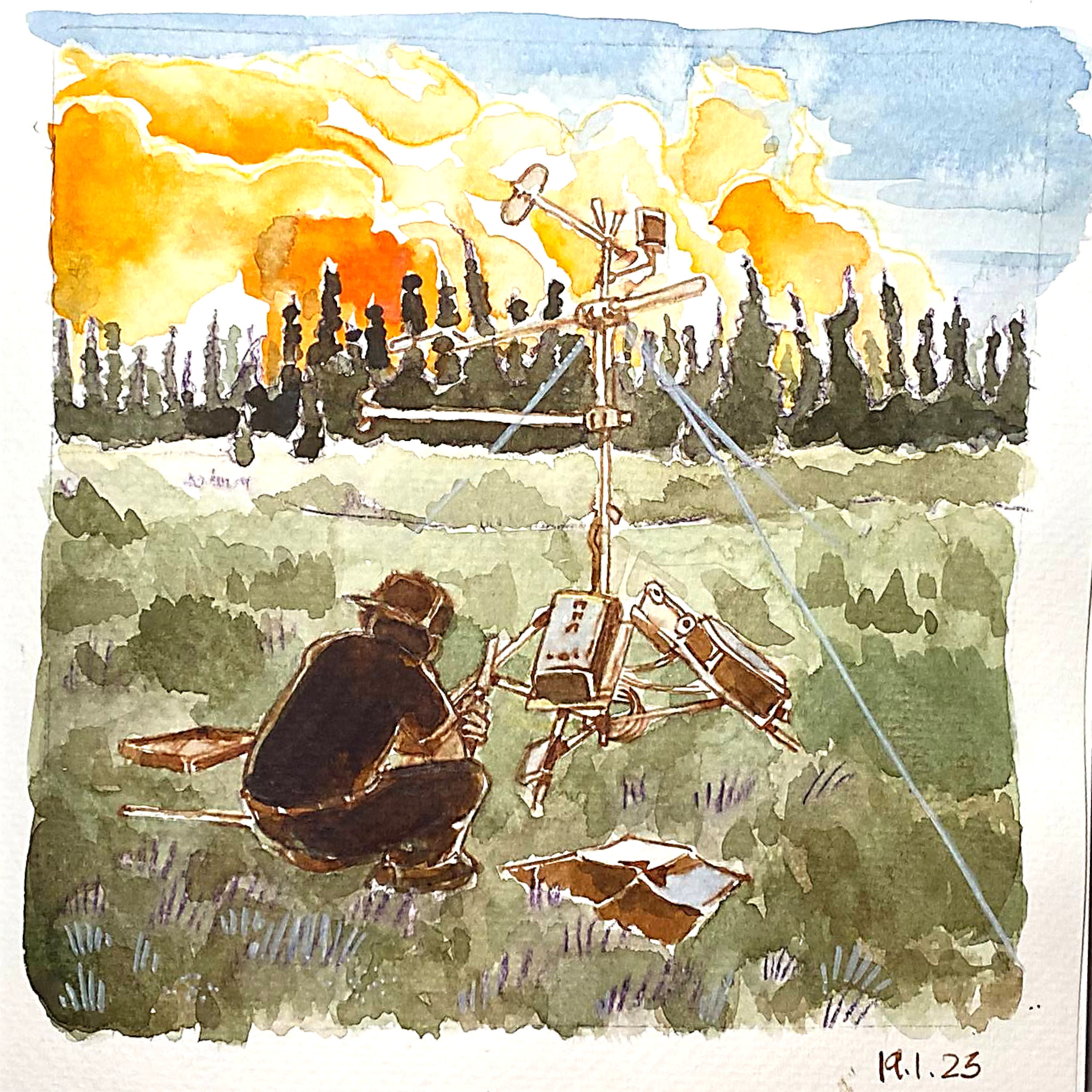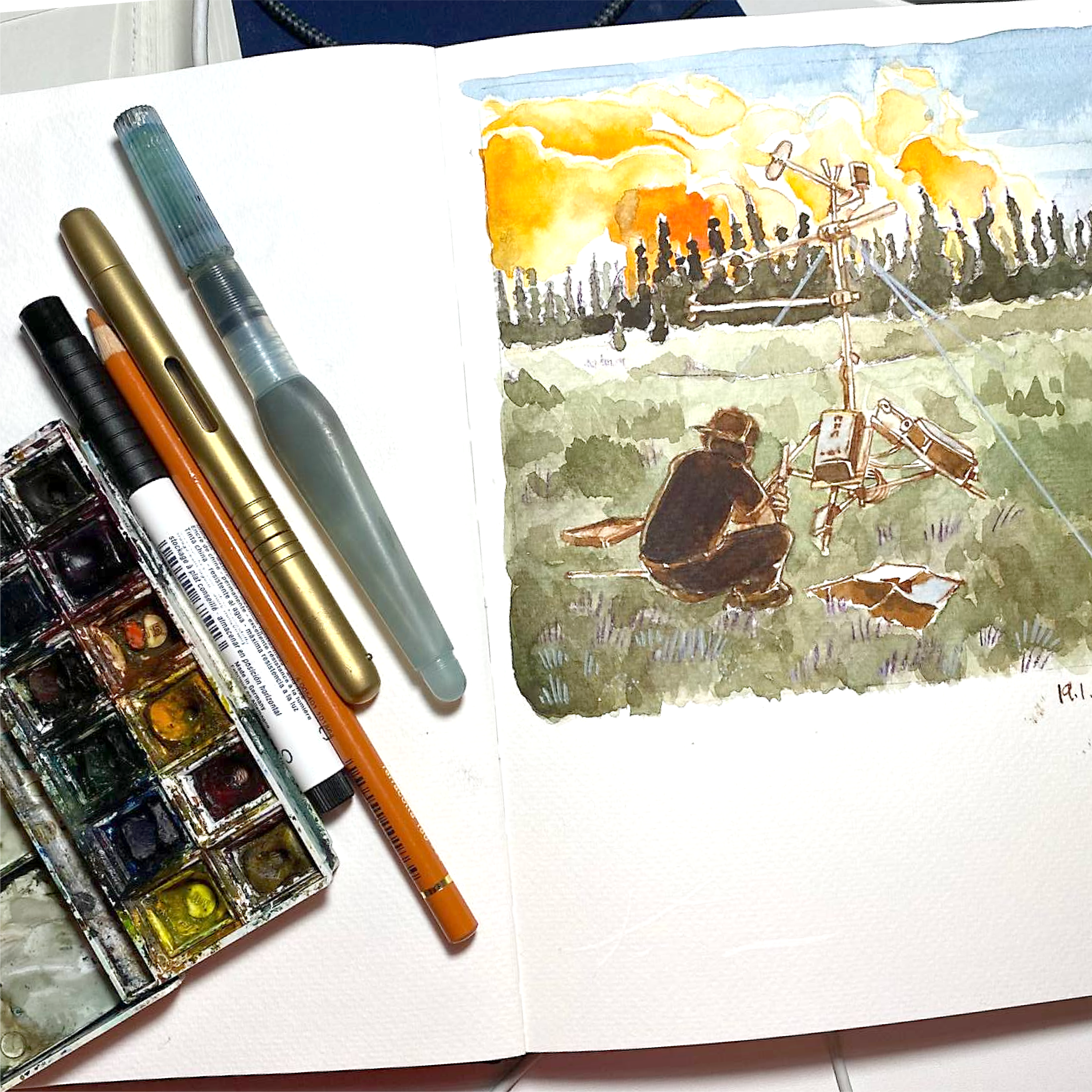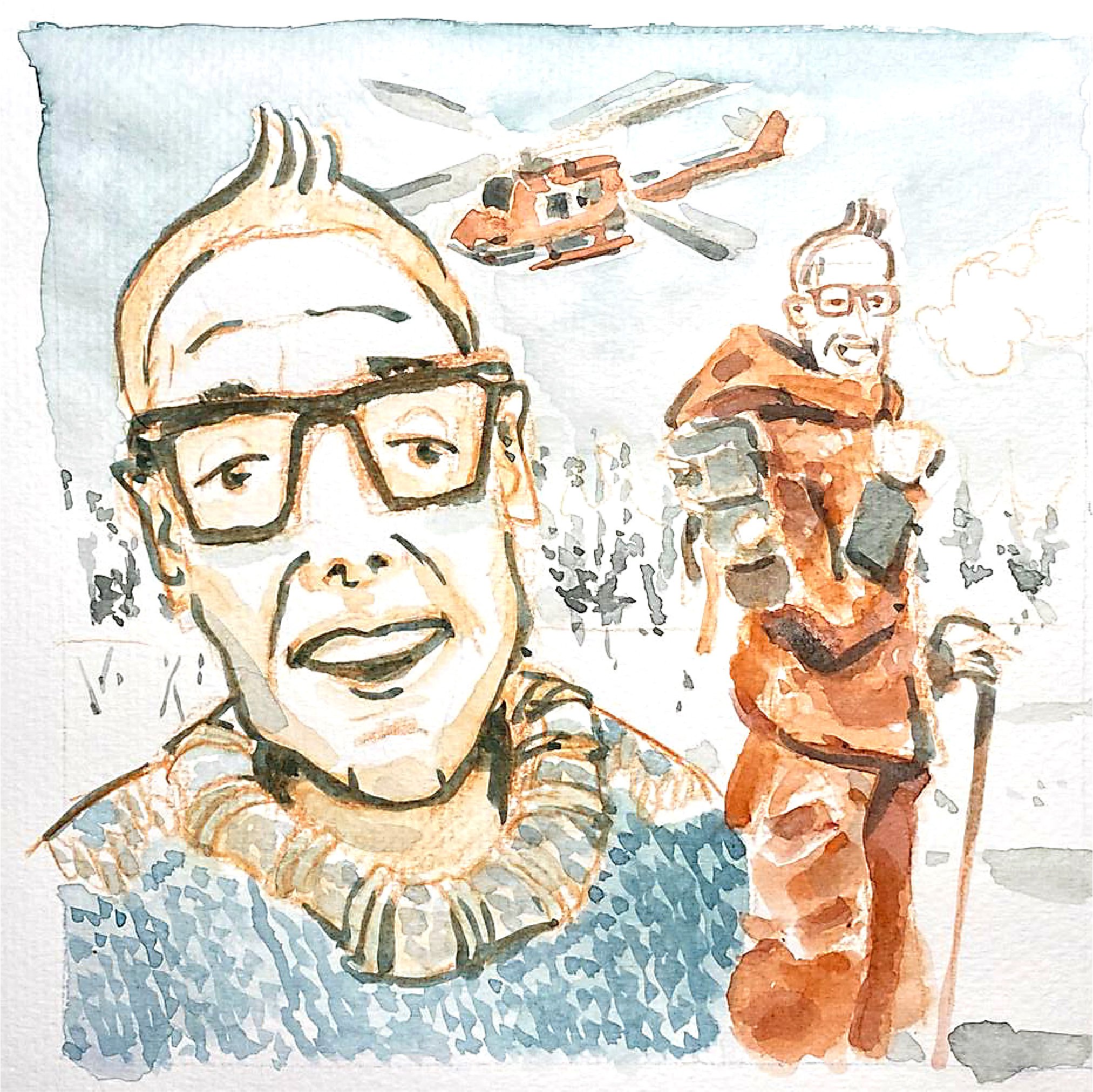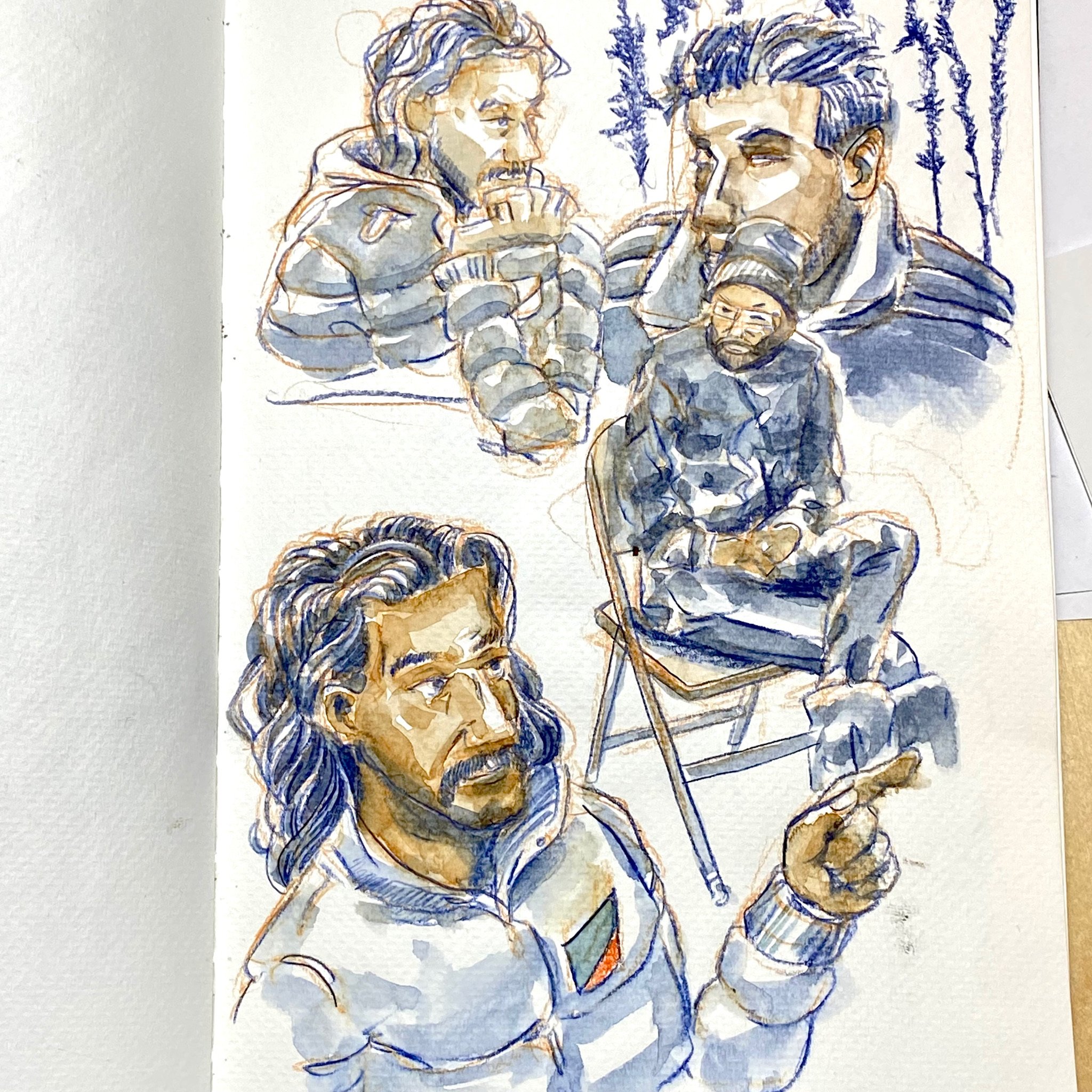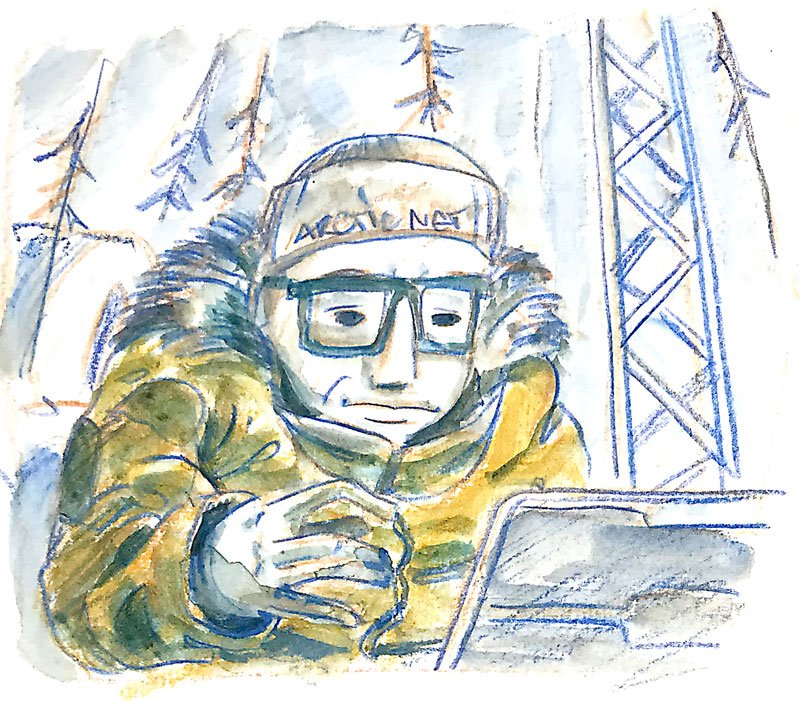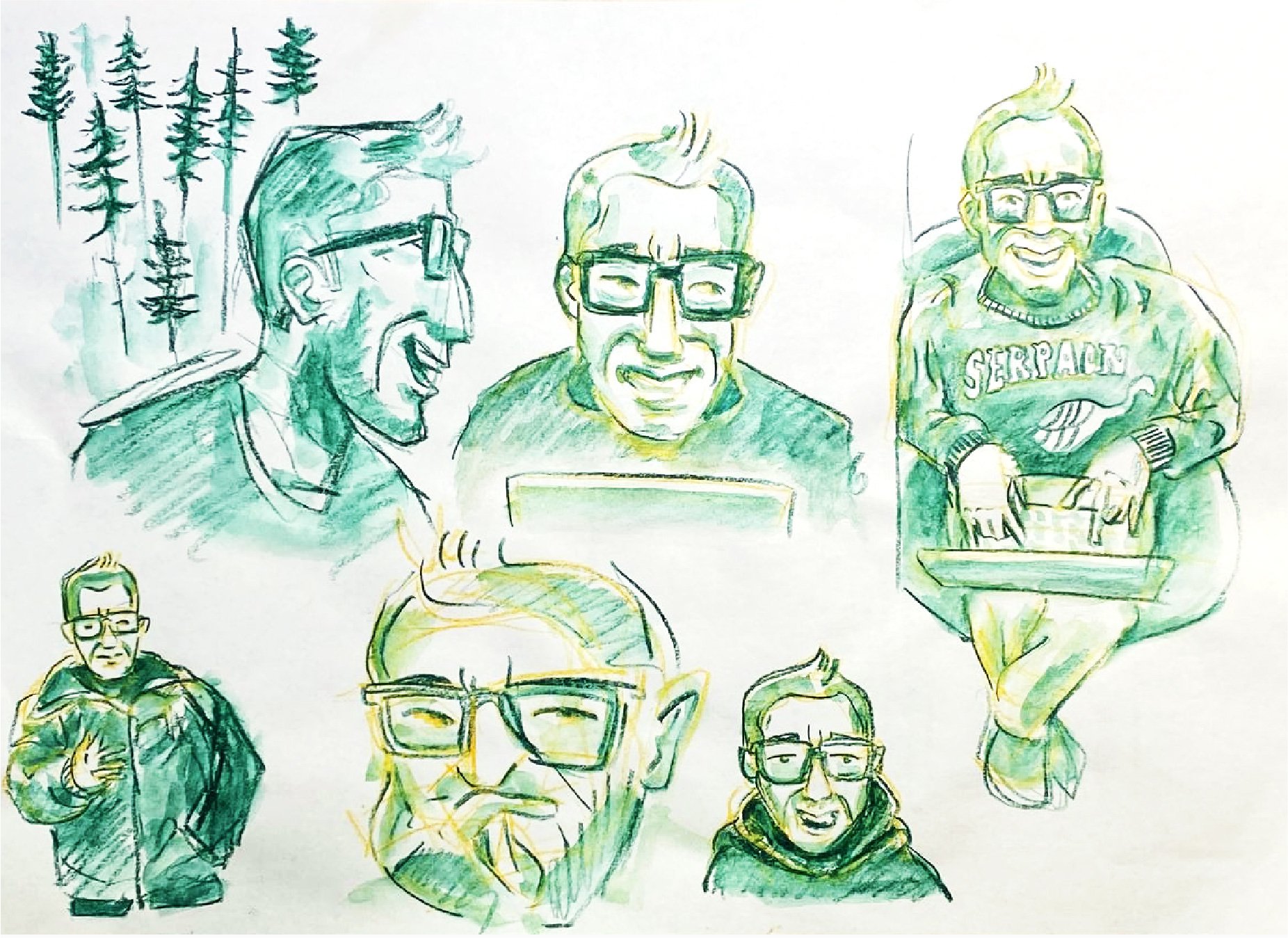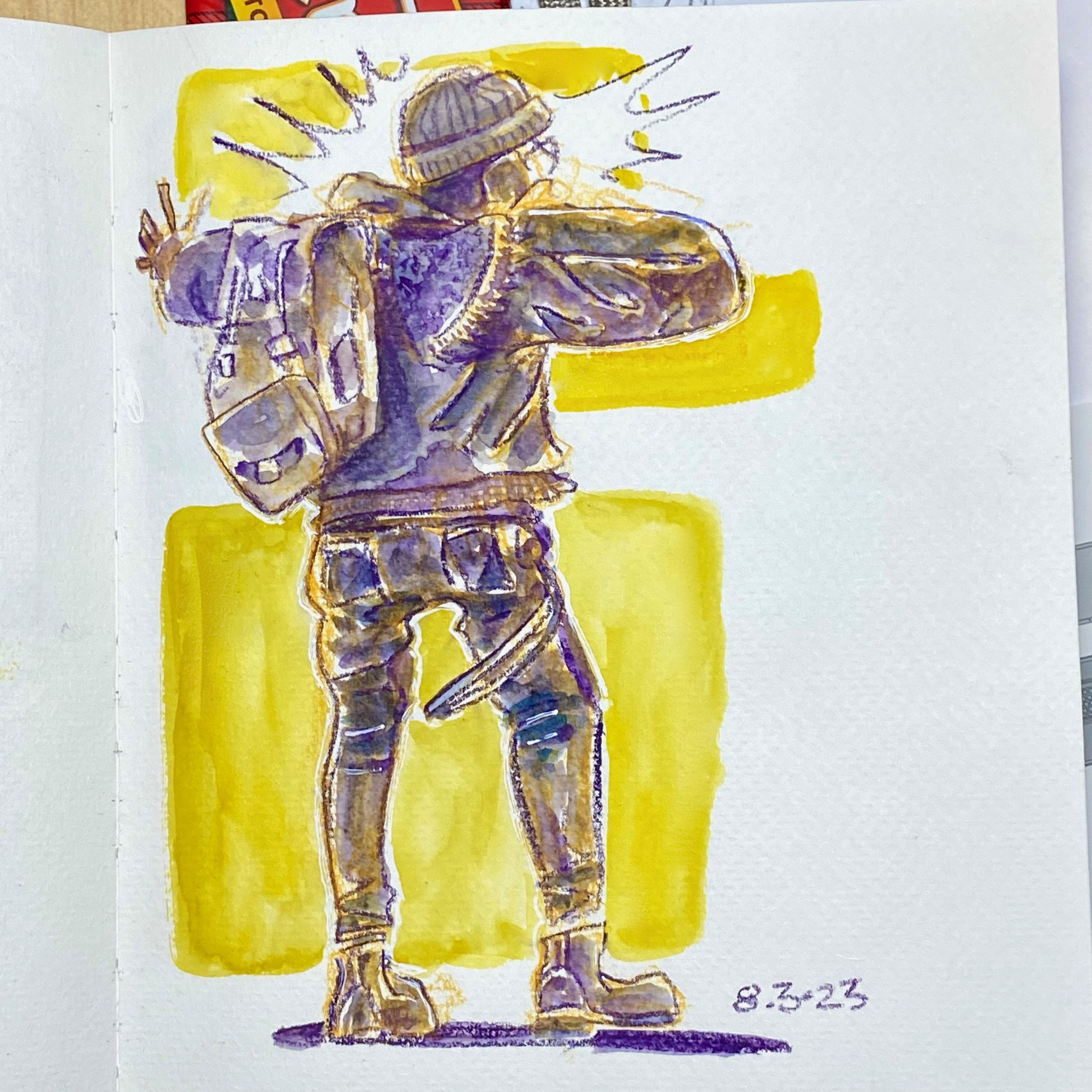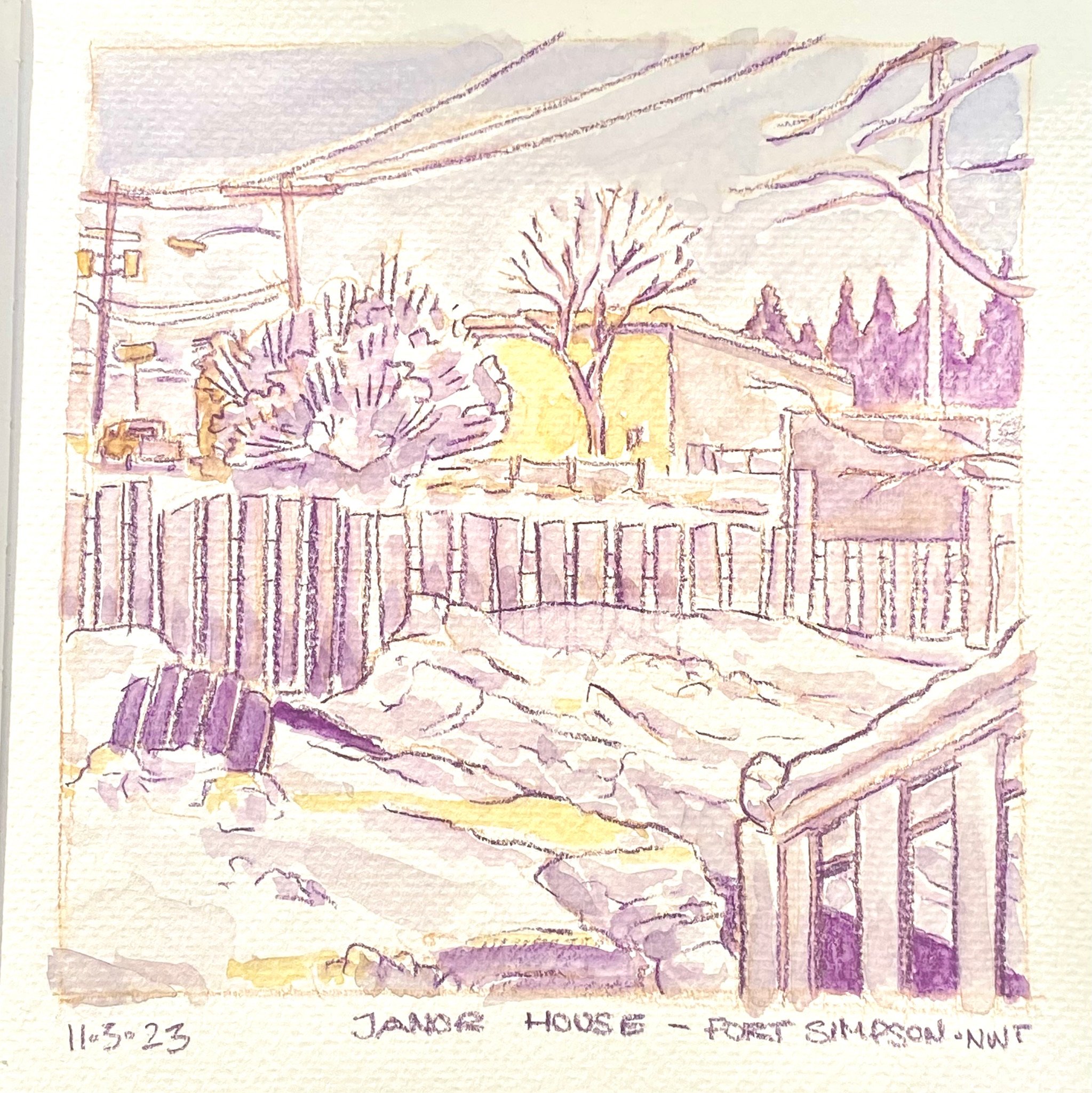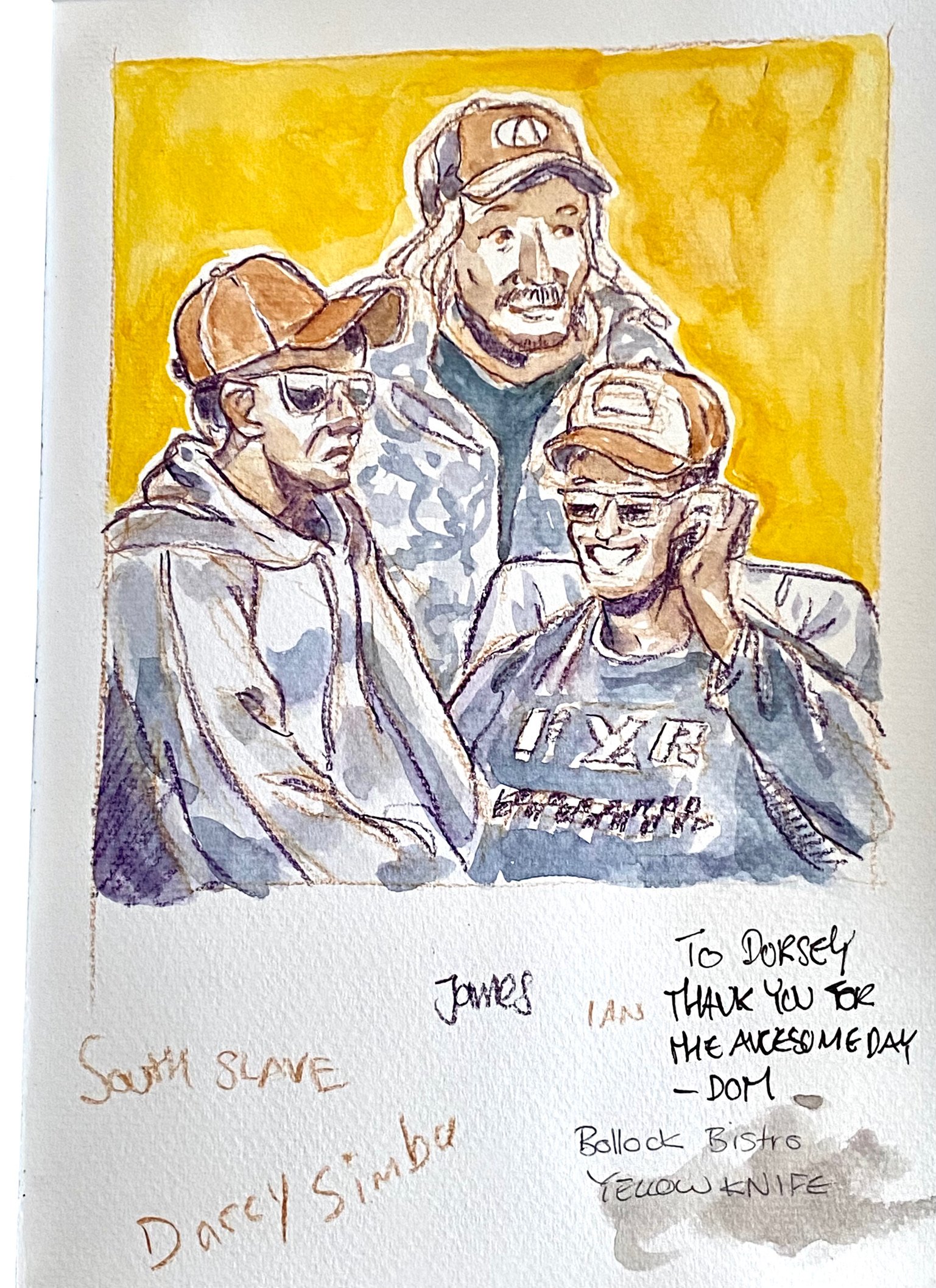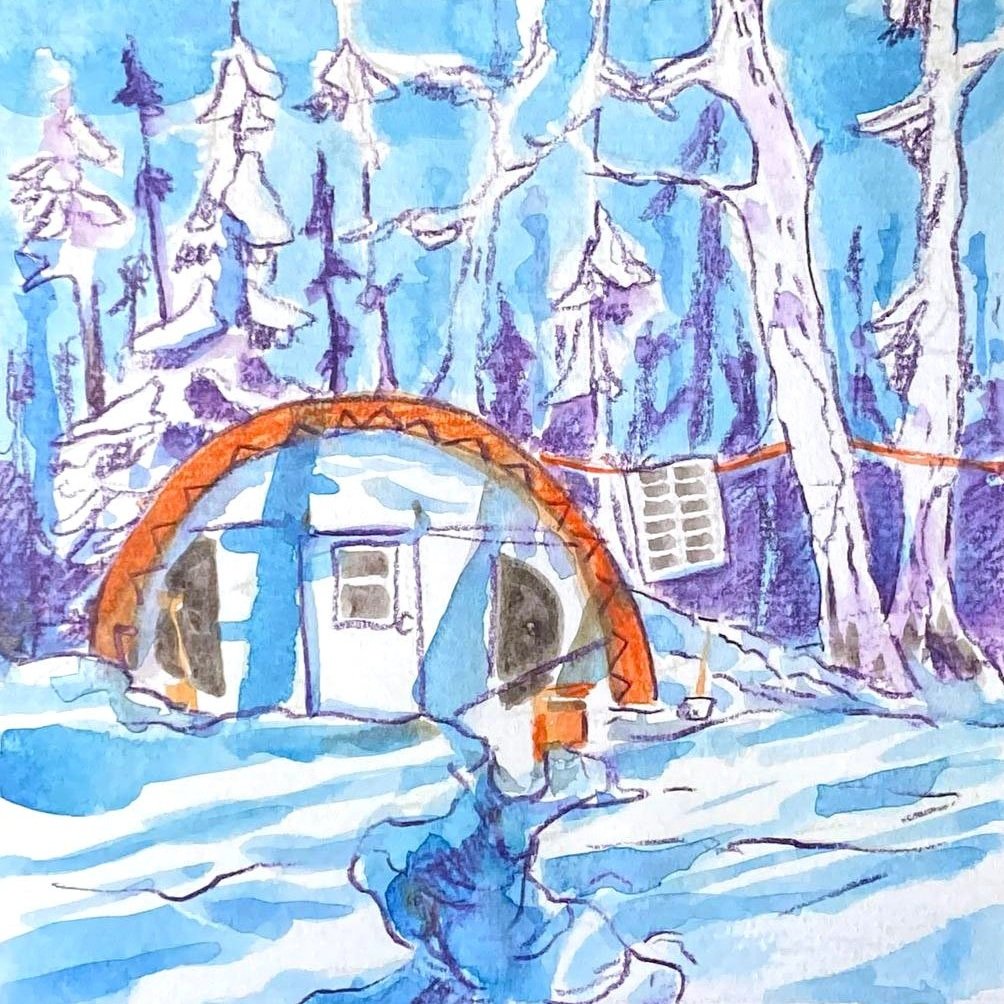Project Presentation
Version 3.0 / June 15th, 2023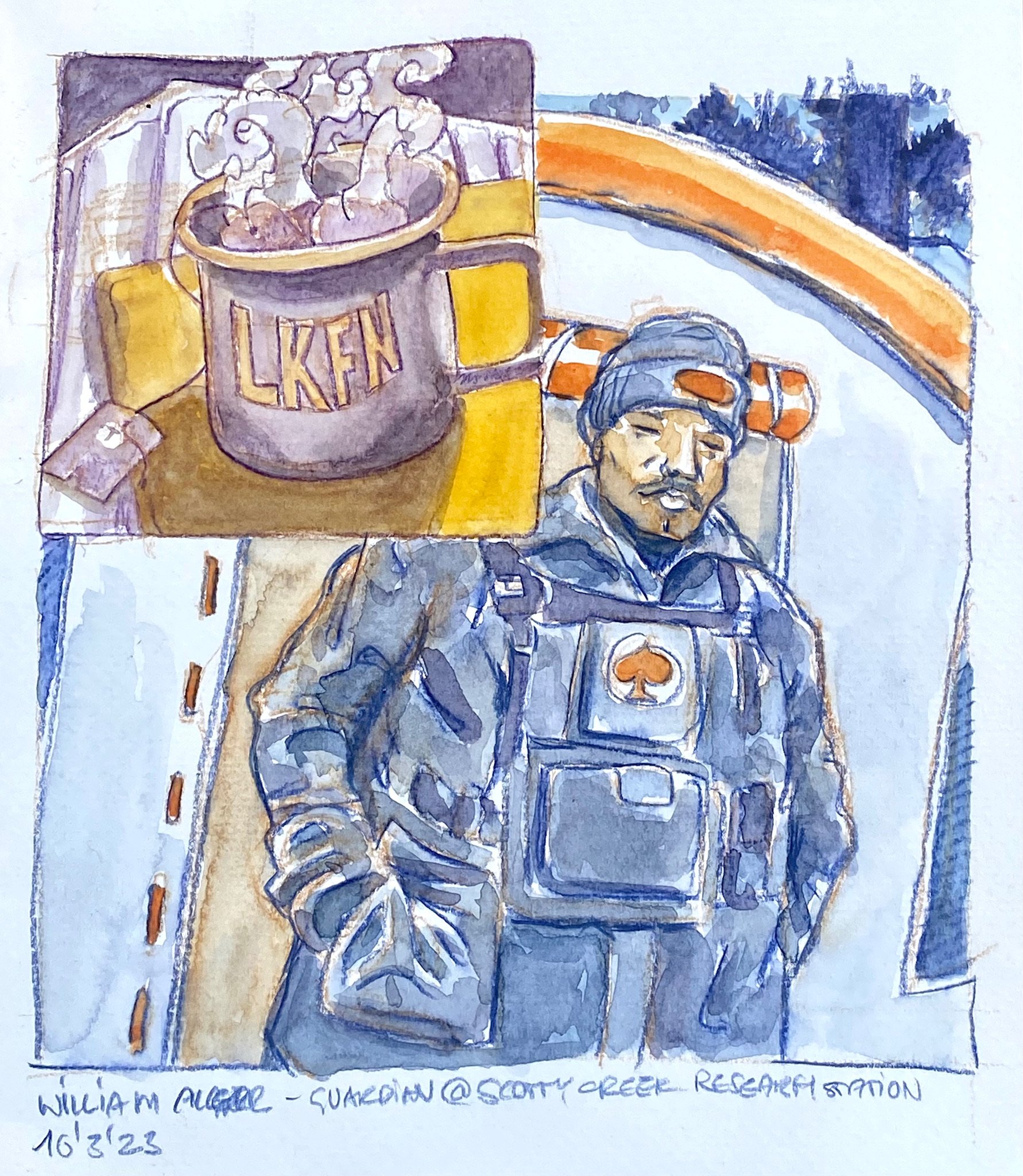
Dehcho Fire
A trip to the Scotty Creek Research Station
Dehcho Fire
is the working title of a work in progress graphic journalism project around the Scotty Creek Research Station in the Northwest Territories led by Berlin based illustrator Dominik Heilig in close collaboration with the filmmaker Jonathan Antoine from Fort Simpson (NT), Professor Oliver Sonnentag from the Université de Montréal.
Below you will find more about the project background, media coverage, photos and drawings

The Story
Burning Forests, Thawing Grounds tells the story of the Scotty Creek Research Station in the face of climate change. Located on the territory of the Łı́ı́dlı̨ı̨ Kų́ę́ First Nation (LKFN) near Fort Simpson a community in the Northwest Territories of Canada, the Scotty Creek Research Station is one of the world’s first Indigenous-led field research stations in the world.
The devastating flood in Fort Simpson in May 2021 became a reminder to Dieter Cazon, a flood victim and the LKFN Director of Land and Resources, to more actively engage with western scientific research and discovery to meet his community’s needs to better prepare for climate change impacts.In the wake of some of Canada’s decolonisation efforts, the research station has been handed over to the LKFN to ensure their authority over their land and participation in the scientific research and discovery world. Tragically, a destructive wildfire strikes soon after the handover, causing significant damage. Despite the challenges, scientists strive to restore a vital research tower used for global climate studies, urgently working against the approaching melting season.The Team
-

Dominik Heilig
Illustrator and author on this project
Illustrator / Comic Author
UI/UX Designer and Product ManagerCurator and designer at the independent Comic Festival – “Comic Invasion Berlin”
-

Prof. Oliver Sonnentag PHD
Scientific Lead on this project
Scientist
Associate Professor, Canada Research Chair Tier 2,
Université de Montréal,
Département de géographie
Atmospheric Biogeosciences -

Jonathan Antoine
Story consultant on local indigenous topics
Łı́ı́dlı̨ı̨ Kų́ę́ First Nation Filmmaker
Based in Fort Simpson -
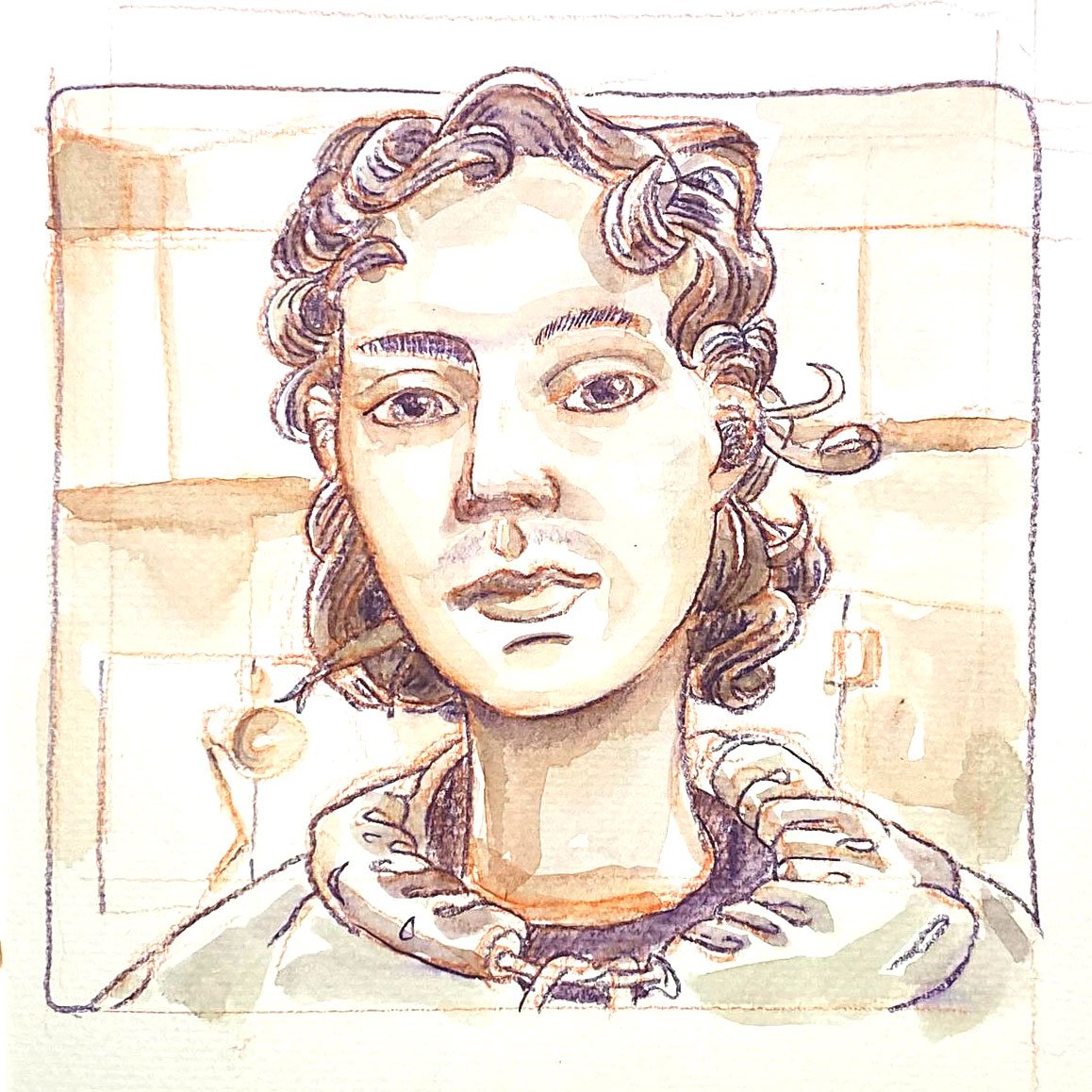
Lyna Mansouri
Research professional
Manager in the Atmobios Lab, Université de Montréal.
What has happened
October 2022 to March 2023
The Scotty Creek Research Station and most of its associated infrastructure was destroyed by a late-season wildfire.
The late-season wildfire also ravaged a 15-m tower structure operated by Dr. Oliver Sonnentag, an Associate Professor at the Université de Montréal. Sonnentag's group (Atmobios) uses micrometeorological techniques to better understand how climate change and permafrost thaw affect important ecosystem characteristics and how the vulnerable boreal peatland complex interacts with the atmosphere.
Together with the Łı́ı́dlı̨ı̨ Kų́ę́ First Nation (LKFN) and in collaboration with scientists from the Woodwell Climate Research Center, Sonnentag's group has begun to rebuild parts of the destroyed research infrastructure in March 2023.
Source: (Woodwell Climate Research Center, 2022)March 2023
Dominik joined the field trip along with Oliver Sonnentag to research and document the rebuild of the micrometeorological tower at the Scotty Creek Research Station (Photos and drawings below).
The journalistic graphic novel will shed light on how research findings obtained with western science approaches connect with traditional Indigenous experiences and perspectives. Focusing on the late-season wildfire and its aftermath.
Oliver and have I known each other since our childhood. Over the last few years, Oliver and I have talked about his research program in the Northwest Territories on numerous occasions. Collectively, these enthusiastic discussions have sparked the idea of a graphic novel around an initial set of sketches capturing people and places.
The project is at a very early stage and the next step is to sort out the learnings from the trip to create a proper story base for the collaboration with the local filmmaker Jonathan Antoine.
Planned Release Date 2024

News & Press
Source: Megan Miskiman/Cabin RadioArticle at Cabin Radio (en)
We were invited to talk about the graphic novel project
The article made it into a NASA ABoVE newsletter
Article at CBC North (en)
The who, how and why about the rebuild of the burnt tower at the Scotty Creek research station (contains some of my photos)
Radio interview in CBC North (en)
Oliver Sonnentag and Dominik Heilig talk about the comic project and the story behind the burnt down flux tower and its role in global climate research.
Article in the L’Aquilon newspaper (fr) Page 8/9
about the re-set up of the tower (contains some of my photos)
Indigenous-led climate research station rebuilds after October
Article at Permafrost Pathways
wildfireMention and usage of photos
Media
Selection of illustrations / studies (12)
More drawings below
Attribution-NonCommercial 4.0 International (CC BY-NC 4.0)
Feel free to use the linked photos and illustrations for news, documentation, or other non-commercial purposes.
Storyboards, Sketches and Studies
With this journalistic graphic novel we want to bring the topic of boreal wildfires and permafrost thaw as a consequence of global and local climate change to a broader audience.
Permafrost is something most people will never be exposed to in their lives. And that’s why its thawing is so underestimated
Want we want to convey
How does this happen
Who is impacted by it
Who are the people in the research teams and how do they work
Who are the First Nations in the area and how are they impacted by the consequences of climate change
Key drivers & measurements
Practical exercises and sheets for schools
What I can’t see
— doesn’t bother me?
More drawings and sketches
on Dominik’s Instagram
Road map
Travel Funding
Research topics: Scotty Creek Site, LKFN groups and individuals, permafrost thaw
Meeting Oliver sonnentag in Stuttgart / interviews / photos
First Drawing Tests
Jan - ‘23
Rough trip planing
First character sheets
Deepen script
Interviews
FEB ‘23
Last Travel preparations
Approve contacts and meetings with Łı́ı́dlı̨ı̨ Kų́ę́ First Nations
Travel to Canada March 7th - 20th.
(Montreal, Yellowknife, Fort Simpson, Scotty Creek Research Station)
Mar - ‘23
Analyse, evaluate and document field trip
Character sheets and studies
Interviews
Script & Storyboard
Apr – Aug ‘23
5 clean pages as part of Berlin Comic Stipend preparation
Interviews
Script & Storyboard
Prepare Stipend Application
SEP ‘23
Apply for Berlin Comic Stipend
(Results by Dec ‘23)
Start the storyboard
Interviews
Script & Storyboard
Oct ‘23
Storyboard
Clean ups
Getting for stipend results
MAY ‘24 - Exhibiting works to date on the Comic Invasion Berlin
Nov ‘23 and Beyond
More Details
Permafrost
Permafrost is frozen soil that has been frozen for at least two years.
Some of it for many thousands of years. Mostly located in the areas of the arctic circle in Alaska, Canada, Scandinavia and.
Permafrost thaw
Permafrost thaw triggers many processes.
Some of them are local, some of them global.
Methane and Carbon Dioxide as are released to the atmosphere due to microbial activity in the thawing permafrost which accelerates global warming
Due to the same process Mercury is released into our water systems
Frozen coast lines are now prone to massive erosion
Big areas turn into swamps and are not passable for people and animals
Sinking ground water levels deprive habitants of their water supply and dry out the remaining soil
Dryer landscapes and forests lead to hard to control wildfires due to a lack of infrastructure which in return releases a lot of CO2
Collapsing landscapes damage the infrastructure like roads, bridges, train-lines and buildings
Wild fires
Fires are an important component of the forest ecosystem. They weed out pests and deadwooed and bring it back to the life cycle.
So called Zombie fires are subterranean fires in the boreal peatlands. They are hard to spot. Especially when smolder quietly beneath the surface – destroying roots of healthy trees and warm up the soil what leads to permafrost thawing.
in 2022 a scientific site has burnt to the ground in the wildfires in Canada’s northern Territories. The fire happened outside the usual periods and in the world of science it was a unique moment to measure the gas emissions DURING the fires until most of the equipement was destroyed.




